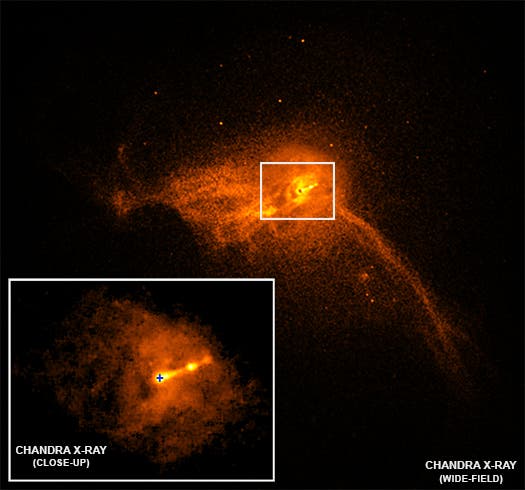You’ve seen the close-up, but have you seen the panorama?
The black hole image published on Wednesday made headlines all around the world — and for good reason. The words ‘groundbreaking’ and ‘revolutionary’ often get thrown around more than they should, but they were well deserved here. But while the media was (rightfully) focused on the black hole image itself, it’s nice to take a step back and look at its galactic neighborhood.
The image above was snapped by the Chandra X-ray Observatory, which was not involved in the Event Horizon Telescope (EHT) array that snapped the black hole image. While Chandra can’t see the shadow itself, its field of view is much larger than the EHT’s — so Chandra got a much better view of the jet of high-energy particles launched outward by the intense gravitational and magnetic fields around the black hole.
NASA’s Chandra X-ray Observatory spent 30,000 seconds watching the supermassive black hole at the center of Messier 87 during the April 2017 observing run by the Event Horizon Telescope (EHT).
To get a feel for just how huge this whole thing is, the jet extends a whopping 1,000 light years from the black hole. An official press release reads:
“To use an analogy, consider a trumpeter in a concert hall: the EHT data, taken from radio telescopes around the globe, provide a close-up view of the mouthpiece (the origin of the sound, like the “central engine” of M87). The Chandra data, by contrast, reveal the sound waves as they travel down the trumpet and reverberate around the concert hall. (As with many analogies, the scale is not exact.) We need both of these pieces in order to understand the sound completely.”
The reason why Chandra was able to snap such a remarkable image is that the elliptical galaxy surrounding the black hole acts as a reservoir of extremely hot gas, which glows brightly in X-ray light. This serves as more than just an image, offering astronomers insight into the behavior and properties of the giant black hole — especially in coordination with data obtained by EHT.
Using the EHT and Chandra simultaneously was important to better understand the astronomic context of the black hole and its surrounding galaxy, says Dr. Joey Neilsen of Villanova University. Any X-ray variations might link temporally to what the EHT was seeing spatially close to the event horizon.
“Chandra’s X-ray observations coordinated with EHT represent an exciting opportunity to connect the dots between high-energy emission and the physics of accretion and ejection at the event horizon,” said Neilsen.
Some of the questions researchers are now trying to answer is whether there was material falling onto the black hole while the EHT was getting its revolutionary image and what was happening to energetic particles near and far from the event horizon during this time.











